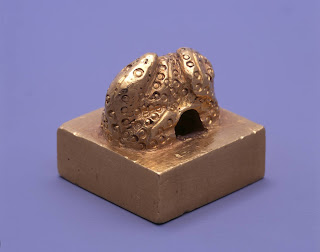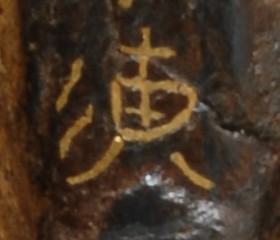The iron sword that I’ll introduce in today’s blog has been most recently designated as an important cultural asset in items currently on display at our museum. The sword was found in 2013 in a tomb in the Motooka Kuwabara Ruins (Nishi ward, present day Kyushu University, Ito campus) in a research excavation held prior to the campus’ relocation.
Today, I’ll recommend a few ways to view this sword in the exhibition room.
See the whole body
Firstly, please take a look at the whole body of the sword.
It’s 74 centimeters in length and it doesn’t have the characteristic curve of a traditional Japanese sword called “Nihon tou.” Most of the swords buried in ancient tombs have straight blade edges just like this iron sword.
Curved swords first appeared in the middle of the Heian period. It might seem a bit confusing because both the straight edge (大刀) and curved edge swords (太刀) are called "tachi" in Japanese, but they are two different things.
Enjoy the glitter
The most significant characteristic of this sword is the 19 golden characters inscribed on the blade. Please take a look at the ridge of the sword.
 |
| It is easier to see them when you look into the case from the left side. |
The knife made of iron has rust all over its body and it doesn’t retain the past silver glitter at all. However, these golden characters still have the glitter of the past that is visible to the naked eye.
The glitter come from gold which has the purity of 91 to 93%. The letters were engraved in fine lines and the gold was applied into the groove. The method is called “金象嵌.”
The letters are not the only glittering part of the sword. When you look closely at the metal collar mounted between the sword blade and the hand guard, you will notice that there are some golden parts in the yellow green surface of the rusted metal.
It means that the metal was once gilded with gold. Please don't hesitate to take a much closer look.
 |
There are some golden parts in collar rim
|
Read the inscribed letters.
There are 19 kanji characters inscribed on the sword.
It read大歳庚寅正月六日庚寅日時作刀凡十二果□(練?).
The last kanji character is illegible. There are several possibilities, such as練,錬or凍.
The character looks easy to read but actually, it isn’t.
The inscription says something like, “I made this sword on January 6th of the year of Koin, on the day and time of Koin.” (Koin is one of the Chinese zodiacs that were used in describing year, date and time). It seems that the creator of the sword found it really auspicious to make a sword in a rare moment in time, in which the Koin was applied to the year, date and time.
So, when was the year of Koin exactly? Koin is one of the 60 zodiacs that is used to describe a year, date and time. The year of Koin comes every 60 years. In Japan, the age of 60 is called “還暦”(還 means, to return暦 means, a calendar), because the person goes through all 60 zodiacs at the age of 60. According to the inscribed characters, the date January 6th must be the date of Koin. From this clue, we can assume that the year of creation of the sword must be around 570, at the end of the Tumulus period. This sword is truly noteworthy for its inscription, because it gives us the clue of its actual date of creation.
How to read the last character determines the meaning of the sentence. There are many possible interpretations. If the character is 練(Training), it can mean the swordsmith practiced sword making enthusiastically. If the character is 錬(to temper), it can mean the swordsmith tempered 12 swords.
In East Asia, there were swords called “三寅剣(Three Tiger Sword)” and “四寅剣(Four Tiger Sword) and this sword is considered to be an older version of such swords. Records suggest that in the Korean peninsula in the 16th and 17th century, such swords were made on the Year of the Tiger, the Month of the Tiger and the Date of the Tiger. The swords created on such a date was thought to have the power to prevent evil.
Comparing the inscribed characters
When you see each individual character, you’ll notice that they were written very precisely. Every stop and stroke was carefully inscribed. Not only the golden glitter, but also the beautiful handwriting are notable about this sword.
Lastly, while admiring the beautiful characters, please make a comparison of the way the word “庚寅” is inscribed, which appears twice in the inscriptions.
 |
| Left picture shows the first “庚寅”, and the right picture is the second “庚寅”. |
By comparing the two inscriptions, we find some differences between them. For example, the first 庚 misses the bottom right stroke. The first 寅 misses the top stroke. The pictures below show that the characters, which were at that time entirely covered with rust, looked exactly the same even when inspected using x-ray.
This tells us that these strokes were already not there at the time the sword was buried in the tomb and thus, removal of the rust didn’t cause the characters to lose some parts. The tomb is considered to be built in the first half of the seventh century, according to the shape of the stone chamber and the earthenware. Traces left in the tomb suggest that the burial practice was conducted multiple times.
The sword, made in 570 AC, seems to have changed hands several times before it was finally buried in a tomb in Itoshima as grave goods.
There are two “日” inscribed on the knife edge, too. Please have a look.
The research mentioned above was conducted by the Fukuoka City Archaeological Center for the preservation of the sword. The whole procedure of the preservation treatment was filmed in a video, which is now available on the homepage of the Fukuoka City Archaeological Center. I recommend watching the video - it’s really interesting!
These are the things that I want you to pay attention to when appreciating the Koin sword. I hope this article motivated you to see the actual sword in the permanent exhibition room. Please study it to find your favorite way of appreciating the sword.
Important Cultural Property
Long Sword (Tachi) with Gold-Inlaid Inscription “Koin”
The sword is part of the collection of the Fukuoka City Archaeological Center and is currently displayed in the Fukuoka City Museum’s permanent exhibition room.
You may present the ticket of the special exhibition “Treasures of Fukuoka” to enter the permanent exhibition room and the feature exhibition room. (The ticket expires on November 30.)











































